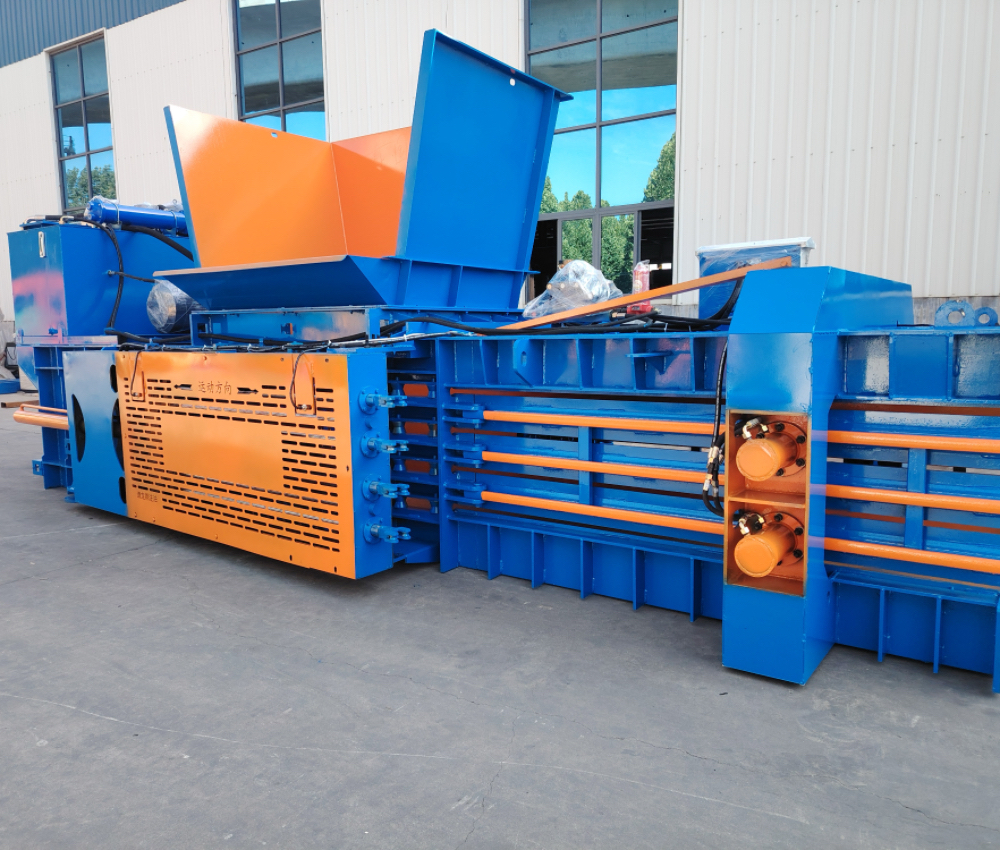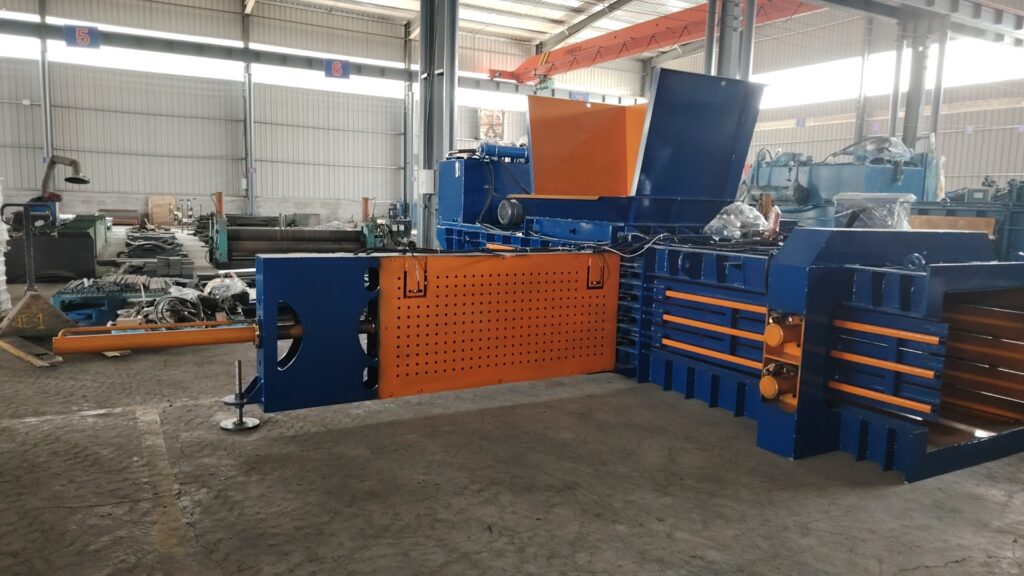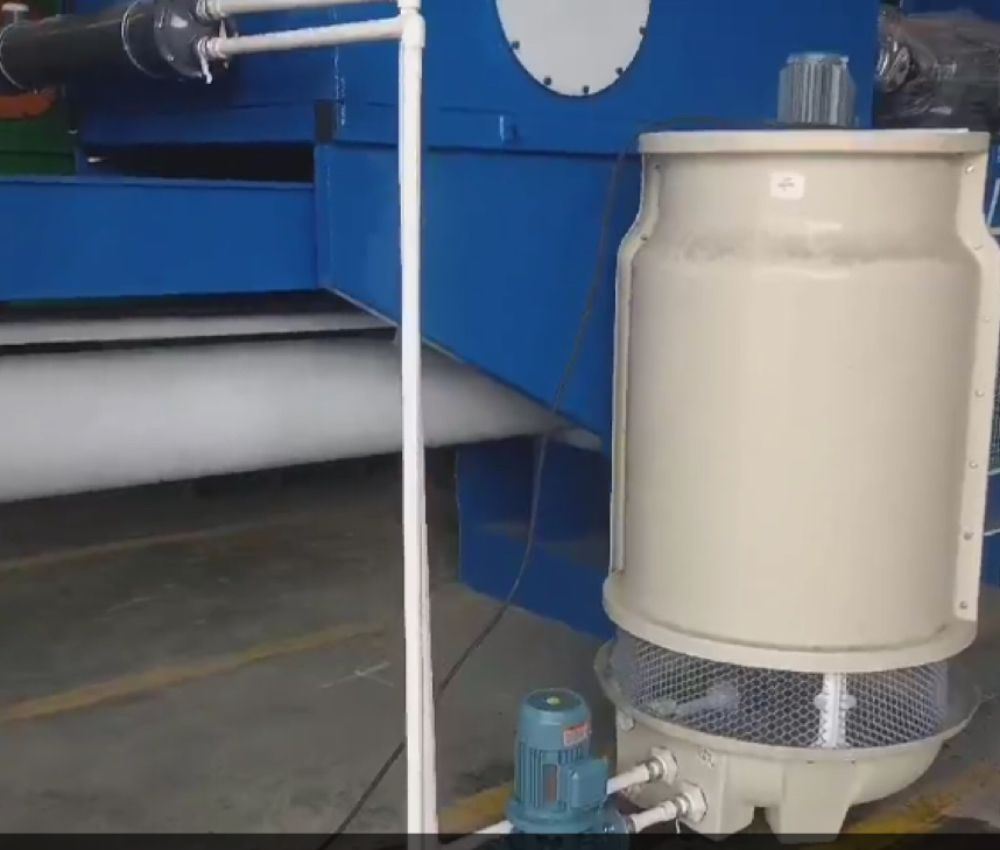What Is A Horizontal Baler Machine?

A horizontal baler machine is an industrial device designed to compress and package waste materials into dense, manageable bales. Unlike vertical balers, horizontal balers feature a horizontal pressing chamber and conveyor feeding system, which makes them suitable for high-volume recycling operations.
This machine is widely used in recycling plants, warehouses, manufacturing facilities, printing industries, and waste management companies. It efficiently handles materials like waste paper, cardboard, plastic films, PET bottles, textiles, and even light metals.
The horizontal structure enables continuous feeding and automatic bale ejection, reducing labor costs and increasing productivity.
Why Is A Horizontal Baler Machine Important?

Modern businesses generate large volumes of waste materials daily. Handling this waste without proper equipment leads to higher storage costs, inefficient logistics, and environmental challenges.
Horizontal balers play a critical role for several reasons:
-
Space Optimization – Compressed bales reduce storage requirements by up to 80%.
-
Transportation Efficiency – High-density bales lower logistics costs by maximizing truckloads.
-
Labor Reduction – Automatic systems require minimal manual handling.
-
Sustainability – Recycling with balers reduces landfill waste and conserves natural resources.
-
Profitability – Selling compacted recyclable bales can generate additional revenue.
For businesses dealing with high waste output, a horizontal baler is not just optional—it is essential.
How To Use A Horizontal Baler Machine

Using a horizontal baler involves several systematic steps:
-
Feeding The Material
Materials like cardboard, plastic, or textiles are loaded onto the conveyor or hopper. In semi-automatic models, operators manually feed materials, while in fully automatic models, feeding is continuous. -
Compression Process
The hydraulic system powers a ram that compresses the material horizontally into the baling chamber. Multiple cycles may be required until the bale reaches the desired density. -
Bale Formation
When the chamber is full, the machine automatically applies pressure to form a dense bale. -
Tying And Securing
Binding materials such as steel wires, polyester straps, or plastic ropes are used to secure the bale. Automatic machines can tie bales without operator intervention. -
Bale Ejection
The finished bale is pushed out of the chamber and ready for storage or transport.
With proper training, operators can safely and efficiently run the baler, ensuring smooth recycling operations.
How To Choose The Right Horizontal Baler Machine
Selecting the correct baler is crucial to achieving efficiency and cost-effectiveness. Below is a practical guide:
1. Determine Waste Type
Different machines are designed for specific materials:
-
Cardboard And Paper → Medium-pressure balers
-
Plastics And PET Bottles → Higher pressure and stronger structures
-
Textiles And Foam → Machines with adjustable pressure and wider chambers
-
Metals And Aluminum Cans → Heavy-duty balers with reinforced rams
2. Estimate Daily Waste Volume
-
Small Businesses (2–5 tons/day) → Semi-automatic baler
-
Medium Operations (5–20 tons/day) → Fully automatic mid-capacity baler
-
Large Recycling Plants (20+ tons/day) → Heavy-duty high-capacity baler with conveyors
3. Consider Bale Size And Density
Choose bale dimensions compatible with your storage and transport requirements. Common bale sizes range from:
-
Length: 1000–1800 mm
-
Width: 800–1100 mm
-
Height: 800–1250 mm
-
Weight: 300–1600 kg per bale
4. Automation Level
-
Manual/Semi-Automatic → Lower cost, higher labor demand
-
Fully Automatic → Higher efficiency, reduced manpower, ideal for continuous operations
5. Power And Motor Specifications
The motor power depends on material hardness and production volume. Options include:
-
Two 30 kW Motors for medium-heavy operations
-
Two 45–55 kW Motors for heavy-duty plants
6. Hydraulic System Pressure
The pressure directly impacts bale density. Typical ranges are:
-
80–120 tons for paper and plastics
-
150–200 tons for mixed recyclables and metals
7. Space And Installation Requirements
Horizontal balers are large machines requiring sufficient floor space. Ensure the site has:
-
Proper electrical supply (380V/50Hz or customized)
-
Strong flooring to support machine weight
-
Clearance for feeding and bale ejection
Matching Machine Parameters To Your Needs
Here is a reference table to help match parameters with operational requirements:
| Requirement | Recommended Parameter |
|---|---|
| Daily Waste < 5 Tons | Semi-Automatic, 80T Pressure, Bale 800kg |
| Daily Waste 5–15 Tons | Automatic, 120T Pressure, Bale 1200kg |
| Daily Waste 15–30 Tons | Automatic, 160T Pressure, Bale 1500kg |
| Daily Waste 30+ Tons | Heavy-Duty Automatic, 200T Pressure, Bale 1600kg |
By aligning these parameters with your operations, you can ensure long-term efficiency, reduced costs, and sustainable performance.
Maintenance And Safety Tips
To ensure longevity and safety:
-
Daily Checks: Inspect hydraulic oil levels and motor conditions.
-
Blade And Wire Monitoring: Replace tying materials regularly.
-
Lubrication: Keep moving parts lubricated.
-
Training: Provide operator safety training.
-
Emergency Stop System: Always confirm emergency systems are functional.
Practical Applications Of Horizontal Baler Machines
Horizontal baler machines are not just theoretical solutions—they are applied across multiple industries every day. In the recycling sector, they handle paper mills’ waste, carton factories’ offcuts, and packaging companies’ discarded materials. Printing houses use them to manage paper trims efficiently, while textile companies rely on balers to compress fabric scraps.
Supermarkets, distribution centers, and logistics warehouses also benefit greatly. Instead of stacking large piles of cardboard boxes or plastic wraps, they compact these materials into transportable bales. This reduces clutter, improves safety, and cuts down on waste disposal costs.
In addition, waste management companies and municipal recycling programs depend on horizontal balers to streamline their operations. By producing uniform bales, they simplify the transportation chain, making it easier to send recyclables to processing plants or resale markets.
The adaptability of horizontal balers also deserves mention. With adjustable bale sizes and customizable hydraulic pressure, one machine can serve multiple purposes. For example, a facility may compress cardboard in the morning and switch to PET bottles in the afternoon. This versatility saves money and space, eliminating the need for multiple machines.
Cost Considerations And Return On Investment
While the upfront investment in a horizontal baler may seem significant, the long-term benefits often outweigh the costs. Businesses save money on labor, transportation, and storage while generating revenue from selling recyclables. Moreover, many governments offer subsidies or tax incentives for companies adopting environmentally friendly machinery, further improving return on investment.
Maintenance costs are relatively low if machines are serviced regularly. Hydraulic oil replacement, motor inspections, and wire consumption are predictable expenses that can be budgeted easily. Compared with uncontrolled waste management, the predictable operational cost of a baler makes financial planning simpler and more reliable.
Conclusion
A horizontal baler machine is a powerful solution for companies handling large volumes of waste. It enhances storage efficiency, reduces labor, lowers logistics costs, and contributes to sustainable recycling.
When choosing a machine, carefully evaluate waste type, daily volume, bale size, automation level, power, and hydraulic capacity. By matching parameters correctly, businesses can achieve optimal performance and maximize ROI.
If you are considering investing in a horizontal baler machine, consult a trusted manufacturer that offers customization, installation support, and after-sales service. The right machine will not only transform your recycling process but also strengthen your company’s contribution to environmental sustainability.
